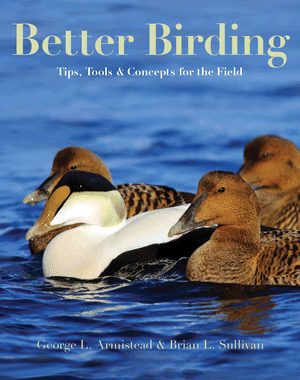Better Birding: Tips, Tools and Concepts for the Field
In comparison, the American Birding Association (ABA) area and its legions of birders have been comparatively starved of such material, but George Armistead & Brian Sullivan's Better Birding: Tips, Tools and Concepts for the Field addresses that to some degree.
The title of this book is actually a little misleading. It's not so much a guide to improving general birding techniques, but an identification guide that covers 24 challenging groups of North American birds. That said, the introduction does offer general guidance and encouragement — I found its positivity and open-mindedness charming and a very much a suitable opening to the book.
While the topics covered are of course focussed on North American dilemmas, there is plenty of relevance for the British (and European) birder. Sure, the yellow-bellied kingbirds and cowbirds sections are likely only to come in useful on a Stateside holiday, but a multitude of chapters are very much topical for 'us': Atlantic gadflies, murrelets, swans, divers and pipits are just a few of these that catch the eye.
The text is comprehensive: each chapter is introduced, includes a 'hints and considerations' and 'identification' sections which are then followed by full text and photos for each species. This is a photographic guide and image quality, as it always tends to be in contemporary times, is excellent. There are also a series of Crossley-style montages scattered around, none of which are too chaotic and therefore work well. The occasional photo caption fails to mention the species name, as if serving as a quiz to help refresh and review each chapter.
There were one or two notable omissions among the chapters — gulls, for example, do not feature (although you could argue there is plenty of literature already available on this topic) and, in my opinion more significantly, nor do Empidonax flycatchers. This cryptic family is arguably the most notorious and challenging group in North America, and a chapter would have been of real interest to American and European birders alike — though in the authors' defence, it's another area that could probably fill an entire book, rather than a small section. There are, however, great chapters on some of the tricky wrens and sparrows of the ABA area.
The size and bulk of this book, while not massive, renders it unsuitable for the field and it is therefore a title for the bookshelf at home. Despite its arguable shortcomings in terms of groups covered, this is a good addition to any birder's bookshelf. While this book does not attempt to nestle itself at the cutting edge of ID evolution (not a bad thing at all) its content is very much relevant to North American and European birders alike, and many will find it a useful title to possess.
- Better Birding: Tips, Tools and Concepts for the Field by George L Armistead and Brian L Sullivan (Princeton University Press, 2015).
- 360 pages, paperback
- ISBN 978-0691129662. £19.95
- Available from the Birdwatch Bookshop from £17.95




